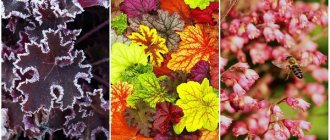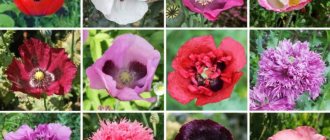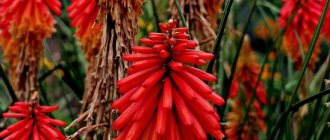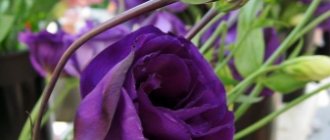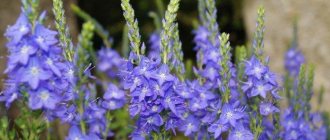Heuchera small-flowered palace Purple castle Heuchera micrantha Palace Purple planting and care photo
Heuchera heuchera is a herbaceous perennial plant of the Saxifraga family, the name is derived from the Latin Heuchera. It is named after the German physician and botanist Johann Heinrich von Heicher. Its roots are from North America. The size of the plant is small, adult bushes of the plant reach 50 cm in height.
Heuchera is a magnificent ornamental plant that is loved by landscape designers because of its brightly colored leaves. The highlight of this exquisite perennial is that during the growing season it can change its color more than once. It is impossible to find among plants a flower more saturated with different shades than heuchera.
Description of Heuchera
Heuchera plant purple midnight rose midnight rose in a flower bed photo
Heuchera is a real find, because its palette will impress even the most demanding gardener, both professional and amateur. It seems that this culture collected all the colors for itself. Starting from silver, yellow, green and ending with black. These are also all shades of red, including purple, burgundy and soft pink. Every year, breeders delight gardeners and designers with new heuchera hybrids. All kinds of patterns, veins, and spots are also characteristic of heuchera. The leaves are leathery, toothed.
There are 3 types of texture:
- smooth
- corrugated
- curly.
Heuchera flowers will delight you until frost with shades of pink, white, red and cream. Small bells are collected in a small panicle, attached to thin tall stems. The seeds are in a small so-called capsule, about the size of a poppy seed.
Heuchera varieties are divided into two categories:
- Ornamental foliage is a plant with gorgeous leaves, such as American Heuchera.
- decorative flowering, for example, blood-red heuchera, which is valued in landscape design for its flowers.
Heuchera is a chic decoration for artificial ponds, a beautiful container plant, some varieties are used for cutting. Looks great with hostas and astilbes in mixborders.
Marmalade
Unlike most varieties of this plant, it is highly undesirable to plant Heuchera Marmalade in full shade. She prefers the sun and “agrees” to tolerate only slight shading, so the ideal place for her is the southwest side of the site.
Plants of the Marmalade variety have leaves that are not the most typical shape for heucheras: they are carved and look a little like bells. Their color is pinkish-burgundy, although the veins practically do not stand out against this background.
This heuchera is not fussy and can be grown as a container plant.
| Bush height (cm) | Bush width (cm) | Distance between plants (cm) | Flowering time | Lighting |
| 30-90 | 30-60 | 45-60 | End of May – beginning of July | Sun, partial shade |
Growing heuchera in the garden
Heuchera in landscape design photo in the garden
Heuchera, despite its splendor, is a rather unpretentious flower. Growing it will not be difficult, just as there is nothing complicated in caring for it.
In order for the heuchera to please throughout the entire period of its growth, you need to know the following features:
- To maintain the aesthetics of the flower bed, it is necessary to remove the flower stalks after the flowers have wilted, maintaining a harmonious appearance of the composition. But this is only if you are not interested in further propagation of the flower using seeds.
- In decorative flowering heuchera species, the peduncle is cut off immediately after the plant has finished flowering.
- The lower leaves tend to fall off. In order to maintain the attractiveness of the flower bed, simply transplant the perennial into a deeper hole in order to cover the bald trunk.
- To avoid drying out, hill up the bush. Sometimes this procedure should be done a couple of times a season.
- Over time, heuchera leaves darken and thicken, but at the very beginning, that is, in the first months, they are brighter and more transparent.
- To create a harmonious design, use compositions from plants such as daylilies, ornamental grasses, and primroses.
Flowering time
The culture throws out its first flower stalks in early June, the last at the end of August or early September. In fact, throughout the summer months, your site will be decorated with picturesque flowering bushes. Although climatic conditions, characteristics of the variety and content are varying factors in the duration of the stage.
In some varieties, panicles even with small bells look original.
In others, the flowering is rather inconspicuous
Still others have peduncles with lush panicles that can compete in attractiveness with other garden flowers. This completely depends on the varietal of the plant.
But in a bouquet, even the most inexpressive heuchera inflorescences successfully complement lilies and roses, and in the area they advantageously set off other neighbors in the flowerbed. Instances with bright colors become an equal element in a mixborder and any other composition.
Planting heuchera in spring and autumn in the ground
How to plant heuchera in open ground photo
This is a shade-loving plant , so it is recommended to plant it in the ground in partial shade, without direct sunlight. The best option is the east side or the west side.
If the flower gets the afternoon sun, then it is necessary to maintain high humidity by abundant watering. You can design the flowerbed so that at lunchtime the bush is shaded by a taller plant. There are exceptions - red varieties. They reveal their palette only in a sunny flowerbed.
The video will tell you where and how to plant heuchera:
There should be no problems with the soil. Any with an acidity of 5-6 is suitable. You can also add dolomite flour or ash to the soil, this will deoxidize it. If you remember where heuchera comes from, namely from the mountainous regions of the country, then you can even plant the flower on a rocky area.
But still, give preference to fertile soil, so the heuchera will reward you with lush and luxurious flowering. Pay attention to the drainage, it should be about 3-5 cm. There should be no stagnation of water, so low areas are not suitable for planting. Experts also recommend sprinkling the rhizome with coarse sand or earth with coarse expanded clay, this will protect the heuchera root from rot. There are two methods of reproduction:
- Seed - they are collected from the peduncle, sown directly into the soil, previously loosened, and covered with soil. In order for seedlings to germinate more evenly, it is necessary to mix the seeds with sand. Before sowing, it is recommended to warm or freeze the soil. Plant in a low container, about 5 cm, with holes and cover with film or glass. After the third leaf, dive (distance 4-6 cm). We remove the cover for the flower. This method is only suitable for ordinary green varieties, because the seeds may not convey any varietal characteristics. A perennial blooms, which grew from seeds in the third year.
- Vegetative is the best option. The reason is that this guarantees the preservation of the varietal characteristics of the plant. It is easy to grow seedlings in a greenhouse from cut cuttings.
Plants are planted in holes 7-8 cm deep. The distance should be 20 cm between bushes. Rooting time is a month or a month and a half.
Ginger Ale
Heuchera Ginger Ale (“ginger ale”) really resembles this golden drink in its color. This plant boasts amber leaves with coral veining and a slight silvery sheen.
Ginger Ale bushes do not like bright sun and feel more comfortable in shaded areas with fertile, moist soil. Heucheras of this variety can withstand both dry and rainy summer months.
| Bush height (cm) | Bush width (cm) | Distance between plants (cm) | Flowering time | Lighting |
| 20-30 | 25-30 | 22-30 | End of May – June | Penumbra, shade |
How to care for heuchera
As for care, then, as mentioned above, everything is elementary and simple and no special troubles are required on your part.
- There is no need to introduce fertilizing in the first year, since it is planted in already fertilized soil, and then reduce the recommended dose on the selected package by half and add before and after flowering, that is, twice a year.
- If this is an ornamental flowering crop, then use a universal fertilizer for flowering plants.
- For decorative foliage heuchera, use complex fertilizer. Mineral fertilizers should be introduced in moderation so as not to overfeed the flower, otherwise it will hurt.
Watering is carried out once every two days under normal weather conditions. You also need to not overdo it. You should not overwater the plant often. On hot days it is necessary to water the flower in the morning and evening. Also pay attention to prevent water from getting on the leaves, direct the stream under the flower to avoid burns. Otherwise, you risk getting unpleasant spotting on the gorgeous leaves. After planting, mulch the soil with peat, so you will forget about drying out and the problem of weeds.
Heuchera from seeds at home Growing seedlings
Heuchera growing from seeds at home Photos of seedlings
When to plant heuchera seeds? Seedlings are planted in March or April. It is not difficult to sow heuchera for seedlings; the rules of care do not differ at all from the usual agricultural techniques for growing small-seeded plants:
- We use a light substrate for planting, or you can use ready-made soil mixture for flowers from the store.
- We only use containers with holes in the bottom for good drainage.
- You need to sow carefully so as not to thicken the seedlings. You can place the seeds on a folded piece of paper and help yourself with a toothpick. So you can easily place the seeds at a distance of 2-3 cm from each other.
- Afterwards, the seeds are covered with a thin layer of earth or sand, gently moistened (with a spray bottle), and covered with glass, transparent plastic or polyethylene.
- Ventilate once a day, and after germination the cover is removed.
- Watering is carried out moderately so as not to provoke the development of putrefactive diseases.
- When the third leaf appears, the seedlings are transferred into separate containers for further growing.
- Two weeks before planting in the ground, hardening is carried out, gradually accustoming the plants to fresh air and sun.
Heuchera flower planting and care photo seedlings
To plant in the ground , the seedlings are carefully removed from the cup and placed vertically in the prepared hole, while simultaneously filling the remaining space with soil. Water abundantly to completely moisten the earthen clod.
Paris
Heuchera varieties with the romantic name Paris (Paris) are characterized by attractive mint-silver foliage with green veins, but this plant is most appreciated for its charming bright pink flowers.
Heuchera Paris is not afraid of pests and diseases, and can survive drought in summer and frost in winter. The main thing is to water it in a timely manner in the heat and additionally cover it in case of severe cold.
| Bush height (cm) | Bush width (cm) | Distance between plants (cm) | Flowering time | Lighting |
| 17-30 | 30-60 | 30-40 | End of May – end of August | Penumbra, shade |
Heuchera propagation by division How to replant a bush
Any experienced gardener knows how to divide heuchera. Beginners will benefit from our simple tips.
- Heuchera bushes are divided in spring or autumn once every 3-4 years, thus both rejuvenation of the plant and its reproduction occur. Otherwise, the bush may become bald. But we don't need this.
- Early autumn or late spring, respectively May or September , is the right time for planting.
- Having dug up the bush, you need to divide it into 2-3 parts.
How to divide heucheras photo
- Take a knife and simply cut the roots into approximately equal parts, being careful to keep the soil on the roots so that the seedlings will take root quickly.
- Plant as usual, watering thoroughly.
Reproduction of heuchera by dividing the bush photo
The size of a suitable hole for planting the separated part is 30 cm by 30 cm. The distance between the bushes is left equal to 25 cm. After planting, it is recommended to water the plant and mulch the space around the trunk. The new bush gains strength within a month.
It is recommended to have a special shaded place in order to propagate plants. The soil should be sandy, you can add ash. And after the newly made bush gets stronger, calmly transplant it to a permanent place.
Delta Don
Heuchera Delta Don (Delta Dawn) is not afraid of any adversity: neither diseases, nor pests, nor dry and hot summer weather, nor rainy summers. This herbaceous perennial feels great in shady and semi-shaded corners of the garden, but can also grow in well-lit areas, although in this case its leaves will lose a little in beauty and presentability. And there really is something to lose!
Over the course of the season, the color of the leaves of this heuchera changes from a lime shade with red veins to a red shade with a golden-yellow border along the edges. Delta Don bushes are quite compact. Ideally, they are planted in groups of willows in mixborders, rockeries, and at the foot of alpine hills.
| Bush height (cm) | Bush width (cm) | Distance between plants (cm) | Flowering time | Lighting |
| 20-30 | 25-30 | 22-30 | June July | Sun, partial shade, shade |
Heuchera propagation by cuttings
Heuchera cuttings photo
The second method of propagation is cuttings.
- In June or July, it is necessary to cut the cuttings so that they do not touch the rhizome.
- It is better to treat the cutting area with a root former; the leaves at the bottom are not needed, they can be removed, and after that the finished cuttings can be planted in peat or sand.
- For good growth and rooting it will take 2-4 weeks, with constant soil moisture and ventilation of the greenhouse.
Heuchera pests and diseases
Heucheras do not get sick often, and if this happens, the situation is not critical. The main thing is not to overfeed the plant and thoroughly drain the soil, because otherwise the perennial becomes weaker and does not resist disease.
If powdery mildew appears on the leaves or root rot, then dig up the perennial and treat it with a fungicide; it won’t hurt to replant it in another place. And if affected by spotting or rust, spray with a solution of Bordeaux mixture once every two weeks until complete recovery. As for pests, you can use insecticides against snails, caterpillars, and leaf nematodes.
Wintering Heuchera
This crop overwinters easily ; a little preparation is enough for comfort. Heuchera's winter hardiness is excellent, but in harsh winters you should play it safe. Leave the dried leaves untouched; later in the spring, after frosts, they are removed with pruning shears to activate and start the growth of new buds. This will additionally protect the plant from severe frosts. The main shelter should be constructed from oak leaves, spruce branches, hay, pine needles, straw or other similar material.
Forever Purple
Heuchera Forever Purple is notable for its luxurious purple foliage that darkens over time to an aubergine purple color. This purple beauty blooms with soft pink flowers.
Plants of the Forever Purple variety can withstand harsh winters and dry summers and do not have any special requirements for lighting.
| Bush height (cm) | Bush width (cm) | Distance between plants (cm) | Flowering time | Lighting |
| 25-30 | 50-55 | 50-60 | End of May – July | Sun, partial shade, shade |
Types and varieties of heuchera Description and photos
There are quite a lot of varieties of heuchera - about 70 names. Most of them grow in forests and near mountain rivers in the USA and Mexico. The main types of heuchera are called: mountain and forest. Below we will look at the most popular varieties, which are used not only for decorating flower beds or creating a unique landscape design, but also for breeding more and more new varieties of heuchera. Hybrids are created in two directions, the first is lush flowering, the second is the decorative splendor of leaves.
Heuchera blood red Heuchera sanguinea
Heuchera flower blood red cultivation and care in open ground Photos of flowers
This variety belongs to the mountain species. It is characterized by pure green leaves, or with small splashes of silver, cream and white leaves. They are denser in structure than the leaves of other varieties of this perennial. The flowers are rich in color, red or dark pink, 1-1.5 cm in length.
The height of the bush reaches 40 cm in length. The peduncle is unstable and thin. Since in nature Heuchera comes from mountainous and northern places, it is very hardy. That's why flower growers loved her so much. The most comfortable place for blood-red heuchera will be a well-ventilated, shady area with excellent drainage. The most common varieties are Monet, Variegata and Hercules.
Heuchera villosa
Heuchera hairy Heuchera villosa in garden design photo
It has velvety and slightly pubescent leaves, quite large in size. The flowers are small, cream-colored, and bloom in June–August. In nature, it can be found in river valleys of the United States. Varieties differ in foliage color.
Heuchera cylindrica
Heuchera cylindrica in landscape design photo
Also a mountain species, with luxurious leaves and a high peduncle, glandular stems reach up to 90 cm. The flowers during flowering are large, they are white, coral, pink and green. The inflorescences are very dense. The leaves are green, toothed, rounded. The striking sheets feature a silver pattern plus veining in a contrasting color. Popular varieties of heuchera cylindrical: Greenfinch, Hyperion, Green Ivory.
Heuchera small-flowered Heuchera micrantha
Heuchera small-flowered obsidian Heuchera-micrantha 'Obsidian' in garden design photo
Bears the title of the most spectacular species. This is well deserved. The thing is that in nature the color of the leaves is purple, and breeders have added brightness to the already chic look. The leaf shape is maple. Peduncle 60 cm, small flowers of creamy pink color. The plant is unpretentious, frost-resistant, loves slightly acidic soil. The variety Palace Purple belongs to Heuchera small-flowered; in 1999 it was recognized as the best perennial.
Heuchera americana
Heuchera americana Dales Strain in landscape design photo
Known as mountain geranium. In nature, American heuchera grows near the Great Lakes. It is attractive for its leaves, namely its red veins. Below is a purple leaf. The shape of the leaf is rounded, and the ends are beautifully jagged. During the growing season it changes color, the brightest shades are in autumn and spring.
Heuchera hybrida Heuchera hybrida
Heuchera hybrid Caramel Heuchera 'Caramel' Coral Bells photo in the garden
It turned out by crossing blood-red heuchera with American heuchera. The leaves, peduncles and flowers are larger than those of its predecessors. The leaves are green with contrasting veins, and the flowers are white, red or pink. Varieties: Cancan, Beauty Color, Cappuccino, Ruby Vale.
Glitter
Glitter is a hybrid of small-flowered heuchera and American heuchera. It attracts the eye with the fantastically beautiful color of the leaves: on the outside they are silver-purple and deep purple on the inside.
It is best to plant Heuchera Glitter on the north-eastern side of the site in the tree trunks of trees and tall shrubs, as it does not like bright sunlight.
| Bush height (cm) | Bush width (cm) | Distance between plants (cm) | Flowering time | Lighting |
| 20-25 | 30-35 | 30-40 | End of May – June | Penumbra, shade |
